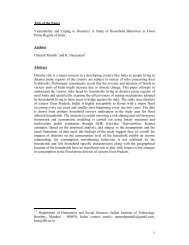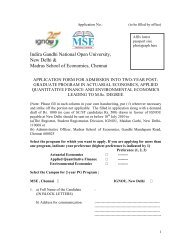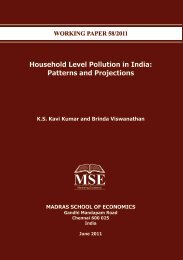Discount Rate for Health Benefits and the Value of Life in India
Discount Rate for Health Benefits and the Value of Life in India
Discount Rate for Health Benefits and the Value of Life in India
You also want an ePaper? Increase the reach of your titles
YUMPU automatically turns print PDFs into web optimized ePapers that Google loves.
INTRODUCTION<br />
Economic analyses <strong>of</strong> life sav<strong>in</strong>g policies require appropriate discount rate<br />
<strong>for</strong> compar<strong>in</strong>g long-term health benefits. It is, <strong>in</strong> general, argued that <strong>the</strong><br />
society’s risk less rate <strong>of</strong> time preference can serve as <strong>the</strong> discount rate<br />
<strong>for</strong> all benefit components if capital markets are perfect. The issue<br />
becomes more complex if capital markets are imperfect <strong>and</strong> particularly<br />
<strong>for</strong> health benefits because human health/life can not be traded explicitly<br />
<strong>in</strong> an <strong>in</strong>ter-temporal market (Moore <strong>and</strong> Viscusi, 1990). In this context,<br />
<strong>the</strong> debate is whe<strong>the</strong>r one can use <strong>the</strong> same discount<strong>in</strong>g rate that is used<br />
<strong>for</strong> evaluat<strong>in</strong>g o<strong>the</strong>r benefit components or one can f<strong>in</strong>d a different rate<br />
<strong>for</strong> health benefits.<br />
Many studies have attempted to resolve this issue empirically by<br />
estimat<strong>in</strong>g <strong>the</strong> discount rate <strong>for</strong> health impacts <strong>and</strong> <strong>the</strong>n compared <strong>the</strong><br />
estimated rate with market rate <strong>of</strong> <strong>in</strong>terest <strong>for</strong> trad<strong>in</strong>g f<strong>in</strong>ancial resources<br />
(eg., Atmadja, 2008; Kula, 2004; Van der Pol <strong>and</strong> Cairns, 2001; <strong>and</strong><br />
Viscusi <strong>and</strong> Moore, 1989). These studies are broadly grouped <strong>in</strong> to:<br />
stated preference studies <strong>and</strong> revealed preference studies. In <strong>the</strong><br />
<strong>for</strong>mer, <strong>in</strong>dividuals are asked to evaluate <strong>the</strong> stylized <strong>in</strong>ter temporal<br />
prospects <strong>in</strong>volv<strong>in</strong>g real or hypo<strong>the</strong>tical outcomes such as health <strong>and</strong> life<br />
years, while <strong>in</strong> <strong>the</strong> latter rates are computed from economic decisions<br />
that people make <strong>in</strong> <strong>the</strong>ir ord<strong>in</strong>ary life (see Frederick et al., 2002 <strong>for</strong> an<br />
excellent survey).<br />
Early studies <strong>in</strong> <strong>the</strong> revealed preference category exam<strong>in</strong>ed <strong>the</strong><br />
consumer’s trade-<strong>of</strong>f between <strong>the</strong> immediate purchase price <strong>of</strong> electrical<br />
appliances <strong>and</strong> <strong>the</strong> long-term costs <strong>of</strong> runn<strong>in</strong>g <strong>the</strong>m. Estimated rates <strong>in</strong><br />
<strong>the</strong>se studies vastly exceeded <strong>the</strong> market rates <strong>and</strong> varied widely across<br />
product categories. Ano<strong>the</strong>r set <strong>of</strong> studies, called labor market studies<br />
have estimated <strong>the</strong> discount rates from wage risk trade-<strong>of</strong>fs. They have<br />
used three alternate but equally plausible models: discounted expected<br />
life years (DELY) model (Moore <strong>and</strong> Viscusi, 1988), Markov decision (MD)<br />
1



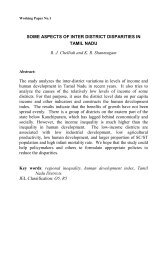
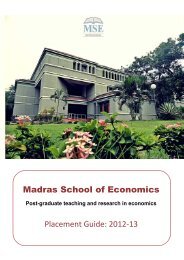
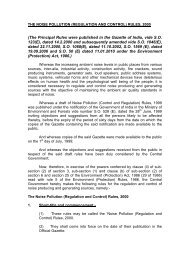
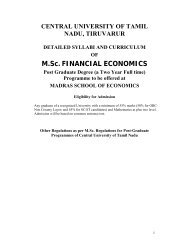
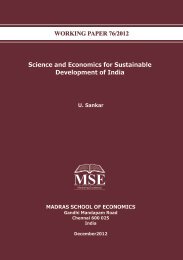
![Curriculum Vitae [pdf] - Madras School of Economics](https://img.yumpu.com/49878970/1/190x245/curriculum-vitae-pdf-madras-school-of-economics.jpg?quality=85)
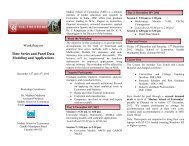
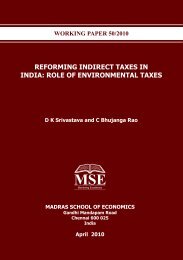
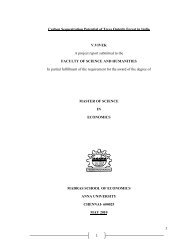
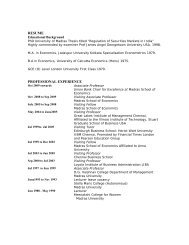
![Curriculum Vitae [pdf] - Madras School of Economics](https://img.yumpu.com/48715201/1/184x260/curriculum-vitae-pdf-madras-school-of-economics.jpg?quality=85)
